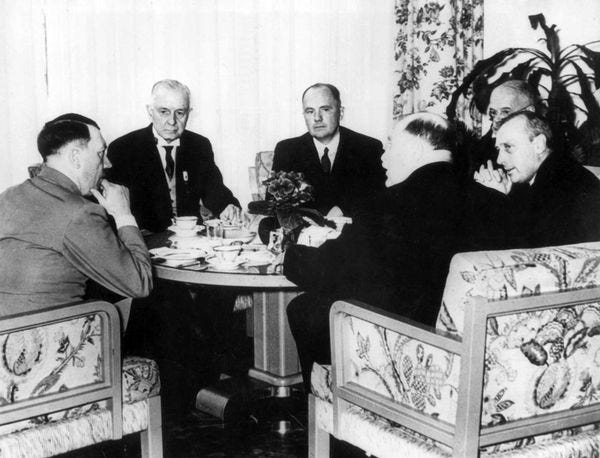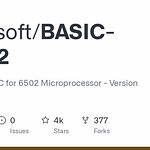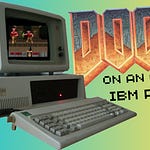As shining as IBM’s track record might appear, there’s a darker side that isn’t often discussed. Today I’m going to talk about IBM’s links to Nazi Germany—how their machines and expertise were used by Hitler’s regime during the Second World War, and not in a little way.
Almost everyone has heard of IBM. They have often been revered as the corporate pride of America. Their products have ranged widely over the years, from pioneering punch card machines in the early 20th century, inventing the modern mainframe in the 1950s, to popularising the personal computer in the 1980s. They’ve been at the forefront of technological innovation for well over a century. They are, by many accounts, the foundation upon which the biggest part of the computing world was built upon.
However, as shining as IBM’s track record might appear, there’s a darker side that isn’t often discussed. Today I’m going to talk about IBM’s links to Nazi Germany—how their machines and expertise were used by Hitler’s regime during the Second World War, and not in a little way.
Before we take an introductory look at what IBM has become in the modern world, I’d like to ask if you’re new here, please don’t forget to hit that subscribe button for more retro computing documentaries as well as videos using and reviewing retro computers.
Don’t forget to watch this video to the end for some insights you won’t believe are part of a secret history of one of America’s darling corporations.
Chapter 1: IBM Today—From humble beginnings to a tech Behemoth
When we talk about IBM in modern times, we’re talking about one of the largest and most influential technology companies in the world. IBM started off in the late 1800s as the Tabulating Machine Company. It was founded by Herman Hollerith, who was born in Buffalo, New York in 1860. He was born to German immigrants, Georg and Franceska. Herman’s father was an interesting fellow by all accounts, he was a free thinker who got caught in the revolution of 1848 in the German states. He left with his family for the United States just after the Prussian suppression of the revolution. Georg died in an accident when Herman was only nine.
Following Georg’s death, Herman’s mother moved to New York City. She made custom hats for socially prominent women. From this income and other family income, they managed to live well enough to pay for Herman’s schooling: at the age of 14, Hollerith began attending the College of the City of New York and laterally Columbia University, where he studied mechanical engineering. Throughout his education, he was known for his inventive nature.
Although Herman’s inventions would eventually apply electricity as a prominent feature, he attended no classes nor had formal training in electricity. It wasn’t until 1889 that it was first taught at Columbia, some ten years after Hollerith's graduation.
Herman’s Tabulating Machine Company (TMC) was incorporated in 1896 and grew across the world, including in Europe and Russia. In 1910, Hollerith contracted a Robert Neil Williams, an American engineer, to establish companies on the continent, including the German Hollerith Machine Company with Limited Liability, abridged to Dehomag. The year after, Hollerith merged the company into a larger corporation called CTR, The Computing, Tabulating and Recording company. In 1914, CTR hired one Thomas J. Watson Sr as its general manager who shortly later became president after a court case relating to his time at NCR were resolved.
(Source: Immigrant Entrepreneurship: Herman Hollerith: https://www.immigrantentrepreneurship.org/entries/herman-hollerith/)
After just four years, Watson built the company into a $9 million a year revenue company. In 1924, Watson renamed the company International Business Machines Corporation, which of course we mostly know today as IBM
IBM grew so powerful that by 1952, with revenues in excess of $890 million (or almost eleven billion in 2025 dollars), the US government decided that the company was so dominant, they filed an antitrust suit against them.
(Source: Thomas J Watson, Wikipedia.)
Today, IBM employs hundreds of thousands of people across the globe. It’s no exaggeration to say that their patents, research, and products have touched every aspect of computing—from mainframes to cloud computing, from artificial intelligence to quantum research.
If you ever hear of “Big Blue,” that’s IBM’s nickname. Even if you haven’t used an IBM product directly, you’re likely using services that run on IBM’s hardware or software in the background—be it in banking, healthcare, or government services or in the cloud when you use the web. For years, they’ve been a leader in:
· Enterprise Servers and Mainframes: IBM’s Z-series mainframes are legendary. They can process massive transactions and are favoured by large financial institutions.
· IBM Watson: A powerful artificial intelligence platform that gained fame beating human champions at the quiz show Jeopardy! in 2011.
· Consulting and Services: Besides hardware and software, especially in modern times, a significant portion of IBM’s business now comes from IT services and consulting.
(Source: IBM Official Website, “IBM at a Glance,” retrieved 2023.)
With a vast array of patents, they’ve long been one of the top patent-holding companies worldwide. In short, IBM is a colossus.
But it didn’t happen overnight. The path to this dominance involved decades of development and innovation. IBM has a long and storied legacy of pushing the boundaries of what’s possible in computing technology.
(Up next, we’ll rewind to IBM’s earlier days, to see how the company laid down the foundation for some of the biggest moments in computing. Let’s journey back in time!)
Chapter 2: The Rise of a Computing Giant
T Pioneering Punch Cards
As briefly mentioned earlier, TMC’s first major success was standardising and selling punch card tabulators. These wild piano sized devices were used to sort and process data using physical punch cards. Long before the digital age, this was the cutting edge of data processing. Government agencies, large corporations, and academic institutions used these punch card machines to manage data in a faster, more reliable way than purely manual systems. The first big success for TMC was back in 1890, where the Hollerith tabulating machine was used to automate much of America’s census.
T Big Iron: Mainframes Arrive
The term mainframe was derived from the large cabinet, called a main frame that housed the central processing unit and main memory of early computers.
In 1937, the IBM Automatic Sequence Controlled Calculator, also known as the Harvard Mark I, holds the distinction as the first mainframe computer. The US Navy used it during World War II to quickly solve ballistic math problems. In 1951, the UNIVAC was the first commercially successful mainframe, which was followed quickly by IBM’s 701. Introduced in 1964, the System/360, was a family of mainframe computers that changed the industry. It standardised computing hardware and software interfaces, making it easier for businesses to upgrade their systems. It was so successful that it effectively cemented IBM’s position at the top of the computing food chain. IBM Mainframes are still dominant today in high computing power tasks and even the new world of quantum computing.
(Source: Emerson W. Pugh, Building IBM: Shaping an Industry and Its Technology (MIT Press, 1995).)
T The IBM PC Revolution
Many of you will know IBM best for the IBM Personal Computer—the Model 5150, released in 1981. With a combination of an Intel 8088 processor, Microsoft’s MS-DOS, and a relatively open architecture, the IBM PC standard quickly became the blueprint for countless “IBM-compatible” machines. Suddenly, computing left the realm of large institutions and was available to small businesses and home users. This PC architecture shaped the future of desktop computing for decades, arguably still to this day.
(Source: Jimmy Greer, “A Brief History of the IBM PC,” Computer History Journal, 2010.)
From that point on, IBM was not just a giant in the corporate sphere but a household name in personal computing, at least for a time.
(Next, stay tuned as we turn back the clock to the early 20th century, where IBM’s punch card technology takes a sinister twist during the rise of the Nazi regime!)
Chapter 3: Setting the Stage—IBM and the World in the 1930s
Before we jump into IBM’s connections with Nazi Germany, we need a bit of historical context. The 1930s were a turbulent time. The Great Depression shook economies around the world. In Germany, the Nazi Party rose to power in 1933, and Adolf Hitler rapidly transformed the nation into a totalitarian state.
As mentioned earlier, TMC started German interests as early as 1910, but it was in 1922 that IBM acquired a controlling interest in a Dehomag (short for Deutsche Hollerith-Maschinen Gesellschaft). Dehomag specialised in punch card technology, just like IBM back in the United States. As the Nazi regime took hold, Dehomag became an increasingly valuable component of Germany’s data processing infrastructure.
(Source: Edwin Black, IBM and the Holocaust (Crown Publishers, 2001).)
T Data, Data, Data
The Nazis were notorious for their obsession with administrative control and record-keeping. They wanted precise information on the population for taxation, drafting soldiers, and—most ominously—for identifying minority groups like Jews, Roma, the disabled, and others they deemed “undesirable.” In an era before digital computers, punch card machines were a dream come true for any government that wanted to centralise data.
The stage was set: IBM had the technology. Germany had the demand.
(Next, we’ll see how the IBM / Nazi relationship evolved—leading to IBM providing the means for a chilling level of population tracking. The story is about to get darker).
Chapter 4: Dehomag and Nazi Germany
By 1933, when Hitler rose to power, Dehomag was effectively IBM Germany. Thomas J. Watson Sr., the then-President and later CEO of IBM, worked to ensure that punch card technology became integral to the new German state’s data operations. Meanwhile, the Nazis quickly realised how invaluable Dehomag’s equipment would be.
T The 1933 Census
One of the earliest and most crucial uses of IBM’s punch card machines was the 1933 German census, the first nationwide census under Nazi rule. The results helped identify and categorise large segments of the population—most notably Jewish communities. Armed with this information, Nazi officials could enact anti-Jewish policies and, ultimately, orchestrate deportations to ghettos and concentration camps.
(Source: Edwin Black, IBM and the Holocaust, pp. 31–50.)
T Punch Card Operations
It’s worth noting that IBM used a proprietary punch card system. Each card was specially designed and manufactured, often coded to track everything from age, religion, and ethnicity, to labour skills. The machines had to be carefully configured and operated by trained personnel—Dehomag employees—to ensure accurate results.
All of this was done under the watchful eye of IBM in New York, which maintained licensing agreements set up Dehomag’s expansions, and collected royalties. While top IBM executives later claimed that they had “lost control” of Dehomag during the war, historical records suggest that they profited significantly and continued to guide their German subsidiary’s operations. Evidence suggests that it was during this time that Dehomag became IBM's most profitable foreign operation, and IBM’s second-most profitable business overall.
(Source: Edwin Black, IBM and the Holocaust, Chapters 2–5.)
T A Growing Moral Quagmire
By the late 1930s, Germany had openly declared its militaristic ambitions, persecuting Jews and other minorities. Yet, IBM’s punch card business in Germany did not cease. On the contrary, it grew. Dehomag expanded into the countries the Nazis occupied, setting up data-processing centres that followed the German Army’s advance.
(Now, if you think this is shocking, just wait: in the next chapter, we’ll explore the most chilling use of IBM’s technology—tracking people in concentration camps. Stay tuned.)
Chapter 5: Concentration Camps and Tracking Systems
One of the darkest revelations in Edwin Black’s book “IBM and the Holocaust” is the extent to which IBM’s punch card systems were used inside and around concentration camps. To be clear, the Holocaust was perpetrated by the Nazi regime. However, the efficiency of the camps—the movement of prisoners, the categorisation of labour, and the grim calculations of life and death—was aided by data-processing technology that originated with IBM.
In Edwin Black’s book, he states that "without IBM's machinery, continuing upkeep and service, as well as the supply of punch cards, whether located on-site or off-site, Hitler's camps could have never managed the numbers they did.”
T Tattooed Numbers and Data Codes
Many of us are familiar with the horrific images of concentration camp prisoners with numbers tattooed on their arms. But it’s less well-known that these numbers often corresponded to coded information from the IBM-Hollerith punch card system. They were essentially human barcodes.
Different punch card fields represented whether someone was Jewish (an 8), Roma Gypsy (12), antisocial (9), homosexual (3). Other fields tracked whether the prisoner was assigned to forced labour, slated for transfer, or in many cases to death. The clinical accuracy of this coding, such as the number 4, for execution or 6 for death by gas chamber, showed that much thought went into IBM’s card system. This data was then collated and analysed to determine resource allocations and to manage the staggering logistics of the Nazi “Final Solution.”.
(Source: Edwin Black, IBM and the Holocaust, pp. 120–150.)
But this was not the first time that IBM had provided such profiling such systems, in 1928, the IBM Hollerith punch-card machine had been used in the Jamaica Race Crossing Study.
T Collaboration vs. Complicity
The big question: Did IBM know? According to historical documentation, IBM’s senior management in New York was kept informed about the operations through regular reports, sales figures, and requests for spare parts or new machines. Every two weeks, requisitions for replacement cards and servicing came to IBM; don’t forget, all of the equipment was on lease.
While we may never know every conversation that took place behind closed doors, there’s clear evidence that:
· IBM collected royalties on every punch card used, including those in Nazi-occupied territories.
· Thomas J. Watson Sr. not only met with Adolf Hitler himself in 1937, but was personally decorated by the Nazi regime with the Merit Cross of the German Eagle, an honour bestowed on foreigners sympathetic to Hitler’s government. Watson would later return this medal in 1940 as international criticism of Nazi Germany intensified.
(Source: Edwin Black, IBM and the Holocaust, pp. 175–210; New York Times, “IBM and Nazis,” article published 29 June 2001.)
In the next chapter, we’ll cover how this horrifying collaboration was rationalised during and after the war, and the eventual response from IBM. Don’t miss it.
Chapter 6: War’s End and the Aftermath
By the end of 1941, the United States had entered World War II. Many American corporations doing business in Germany claimed they had lost contact with or control of their subsidiaries. IBM was no exception, stating that war-time conditions made it impossible to oversee Dehomag’s activities properly.
Yet, records indicate that even after the U.S. entered the war, profits from Dehomag continued to make their way back to IBM. Some historians argue that IBM engaged in deliberate obfuscation, routing money through neutral countries like Switzerland.
(Source: Edwin Black, IBM and the Holocaust, Chapters 8–9.)
T Post-War Investigations
After Germany’s defeat, there were some inquiries into IBM’s role. However, the main focus of post-war tribunals was on high-ranking Nazi officials and military figures. Large-scale corporations—both German and foreign—faced relatively minimal scrutiny compared to the Nazi leadership. As a result:
• IBM was not formally charged with any war crimes or complicity.
• Thomas J. Watson Sr. remained an influential figure in American business circles.
• IBM continued to prosper, eventually shifting attention to rebuilding Europe through initiatives like the Marshall Plan and continuing innovations in data processing technology.
T Edwin Black’s Revelations
Most of the modern knowledge about IBM’s involvement stems from the pioneering research by Edwin Black, a journalist and historian who dug into thousands of documents, letters, and corporate records. His book, IBM and the Holocaust, published in 2001, caused a stir and prompted renewed examination of corporate complicity in the Holocaust.
(Source: Edwin Black, IBM and the Holocaust (Crown Publishers, 2001).)
When challenged by the revelations in Black’s book, IBM did not explicitly deny the evidence offered but criticised the research methods and Black’s accusatory conclusions. IBM have never apologised for their involvement in the war, likely as doing so would have undoubtedly meant confessing to deliberate involvement. Instead, IBM claimed that they did not have any information about IBM’s German division during its World War II period, instead they argued that most documents were destroyed or lost during the war.
On the 20th anniversary of the book in 2021, an unchanged reprint was issued by Black. Despite IBM’s protests, according to Black, [quote] "IBM has never requested a correction or denied any facts in the book”.
(Next, we’ll reflect on how IBM’s story fits into the broader tapestry of technology’s role in society—and what lessons we might take from it today.)
Chapter 7: Lessons and Reflections
As we look back on IBM’s history, we see a company that spearheaded some of the greatest innovations in computing—punch card systems, mainframes, the IBM PC, and even modern AI and quantum research. Their legacy in the technology sphere is undeniable.
At the same time, IBM’s complicity—or, at the very least, indifference—in providing critical technology to the Nazi regime offers a stark reminder that technology itself isn’t inherently good or evil. It can be used to cure diseases, process payrolls.
Believe it or not, one hundred years after the Hollerith machine made its first success in the American census, The Hollerith machine was inducted into the National Inventors Hall of Fame in 1990 as recognition of the importance of supporting some of mankind’s greatest statistical, computational and scientific feats. Hollerith’s machine transformed data tabulation from a manual burden that was stifling society’s advancement to a powerful agent for understanding the world around us. Whilst all of this may be true, it was also clear that used in the wrong hands, the technology can be used to commit atrocities.
This isn’t a moral condemnation of IBM as a company, or every employee, past or present. Indeed, many IBM’ers may have never known the specifics of Dehomag’s dealings, and many who did might have felt powerless to stop it. Some may have quite simply turned a blind eye for profit. But these events highlight an ethical dimension that often gets lost in the excitement of technological progress or corporate greed.
T Why This Matters for Retro Computing Enthusiasts
So, you might ask: “What does all this have to do with retro computing?” Well, a few things:
Firstly, Historical Context: Many of our beloved retro machines - be they IBM PCs or systems influenced by IBM’s architecture - trace their lineage to a company with a complex moral past, littered with examples of corporate greed and questionable political involvement.
Secondly, thinking back to even older, seemingly primitive technologies like punch card tabulators can be used to wield enormous power. It’s a lesson that resonates strongly today, in our era of big data and AI.
Conclusion—A Legacy of Innovation and Controversy
Since IBM’s humble beginnings with punch cards for the American Census, through their golden age of mainframes and on to the dawn of the personal computing revolution, IBM are a company that always continued to innovate, yet grow with massive wealth.
IBM’s ongoing innovations in AI, cloud services, and quantum computing still shape our world. Whilst IBM might no longer be the lynchpin of the corporate world that they were at their height between the 1960’s and the 1980’s, they remain a huge name of the global tech industry, employing legions of researchers and engineers who are, in many cases, working towards a better future. Yet the shadow of their past dealings in their lesser-known collaboration with Nazi Germany reminds us of an essential truth: With great power comes great responsibility.
Remember, the machines we admire aren’t just metal and silicon—they’re built by people, shaped by decisions, and woven into the fabric of history, both the good and the bad
I hope you’ve found this exploration informative and perhaps a bit thought-provoking. If you did, please consider liking this video and subscribing to the channel. I’d love to hear your thoughts in the comments—especially if you’ve got stories, insights, or questions about IBM or any other retro computing topic.
Check out Al’s Geek Lab On the web & social media:
www: https://www.alsgeeklab.com
References
1. Edwin Black, IBM and the Holocaust (Crown Publishers, 2001).
2. Emerson W. Pugh, Building IBM: Shaping an Industry and Its Technology (MIT Press, 1995).
3. Jimmy Greer, “A Brief History of the IBM PC,” Computer History Journal, 2010.
4. IBM Official Website, “IBM at a Glance,” retrieved 2023.
5. New York Times, “IBM and Nazis,” published 29 June 2001.
6. Various newspaper articles (including The Guardian) discussing IBM’s response to Edwin Black’s publication in 2001.
7. Immigrant Entrepreneurship: Herman Hollerith: https://www.immigrantentrepreneurship...
8. Thomas J Watson: Wikipedia: https://en.wikipedia.org/wiki/Thomas_...
TOC: 0:00 Introduction 1:20 Chapter 1: IBM Today: humble beginnings to tech behemoth 6:25 Chapter 2: The Rise of a Computing Giant 9:23 Chapter 3: IBM and the world in the 1930s 11:13 Chapter 4: Dehomag and Nazi Germany 14:01 Chapter 5: Concentration Camps and Tracking Systems 18:00 Chapter 6: War’s End and the Aftermath 20:56 Chapter 7: Lessons and Reflections 24:00 Conclusion: A Legacy of Innovation and Controversey #retrocomputing #vintagecomputing #infosec #ibm












